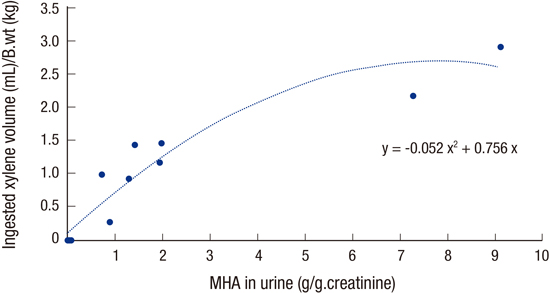INTRODUCTION
MATERIALS AND METHODS
Case recruitment
Table 1
Demography, chief ingredients, and ingested volume of pesticide and xylene in 11 cases in which the pesticide formulations were available

Urine sampling and assay for MHA
Derivation of a regression model to predict the ingested xylene volume from urine MHA
Effect of urine MHA on the clinical outcome
Statistical analysis
 | Fig. 1Correlation between urine MHA level and ingested amount of xylene in 11 cases. The best fit equation between urine MHA and ingested amount of xylene was; y (ingested amount of xylene, mL/kg = −0.052x2 + 0.756x (x = MHA in urine in g/g creatinine).
MHA = methyl hippuric acid.
|
 | Fig. 2The accuracy between the TV and PV of the ingested xylene volume. (A) Scatter plot of TV and PV for ingested xylene amount. (B) Bland-Altman plot. Horizontal lines are drawn at the mean difference, and at the limits of agreement, which are defined as the mean difference ± 2 times the SD of the differences. Note that all data are within 2 SDs of the mean value.
TV = true value, PV = predictive value, SD = standard deviation, CCC = concordance correlation coefficient, CI = confidence interval.
|
RESULTS
Xylene-rich pesticide class
 | Fig. 3Estimated ingested volume of xylene according to pesticide class. The pesticide classes in which the ingested xylene volume was greater than the upper limit of the base line (i.e., 0.01 g/g creatinine) in more than one patient were chloroacetamide (n = 6), dinitroaniline (n = 2), organophosphate (n = 24), oxadiazole (n = 1), and pyrethroid (n = 14). |
Xylene-free pesticide class
Association of pesticide intoxication severity with potential risk factors in pesticide intoxication
Table 2
Association of intoxication severity with the potential risk factors in patients with organophosphate and pyrethroid intoxication





 PDF
PDF ePub
ePub Citation
Citation Print
Print




 XML Download
XML Download